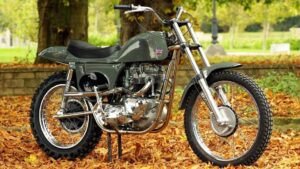When Brice Hennebert, founder of Workhorse Speed Shop, was commissioned to build a bike based on the Indian FTR, his instructions were simple: form a design that successfully incorporates the colours of the iconic Martini Racing livery. He has achieved that in spades. With the new Indian FTR AMA, Hennebert has combined the influences of AMA SBK racing bikes and Group B rally cars from the ’80s, into one sleek-looking motorcycle.
Hennebert began work on this beast in February of last year. After tasting previous success with two mind-blowing Appaloosa builds, he was tasked with building not one but two FTRs – the yet to be unveiled Black Swan and the resolutely retro FTR AMA you see here.
“The brief was pretty open, something colourful and as sharp as a war tank. The only restriction was that the paint be inspired by the Martini Racing livery… The main influences were the Lancia Delta HF mixed with Bol d’Or 750s and some muscle bike DNA.”

RELATED: Ducati’s New Streetfighter V4 SP Serves Up $50,000 Worth Of Thrills
When Workhorse first began forming this bike, it was immediately decided that it would retain an upright riding position, something close to the original FTR, as well as keep the handlebars of the original. From there, the similarities cease.
An OEM dash from the new Indian Chief sits nestled behind the front plate, a design element that – while in keeping with this vibe of retro racing – comes equipped with all the options of the modern machine (such as phone connection and charging).

The chassis plates were machined from Brice’s CAD designs by Vinco Racing in Holland, an element of redesign also in service of achieving this race-like look. The swingarm components, braking brackets, yokes, fuel cell components, the front brackets for the oil cooler and all of the other machining work were all undertaken by Vinco Racing.
The team employed a lot of 3D printing to achieve the results we can see below. This of course includes the bike’s front plate, which houses a PiAA race light and supports the Setrab oil cooler beneath. The printed module that includes the seat pan and taillight also functions as the battery holder. The battery has notably been moved into the rear as a nod to endurance bikes.

As a way of accommodating the bike’s set of DNA performance air filters, the intake was also redesigned and 3D printed. In addition to this, two aluminium fuel cells were fabricated to fit the new bodywork, one under the tank cover and the other which hangs under the seat unit. The capacity matches the 14 litres of the original bike and is linked by the AN10 connectors.
The paint job is designed by Axecent in Japan and is complemented by the saddle, which is upholstered in smooth brushed leather by long-time collaborator, Jeroen from Silver Machine, The tail section is also completed by an old school taillight adapted to take LEDs. We are left in total envy of the lucky bastard that gets to ride away in this bad boy.















